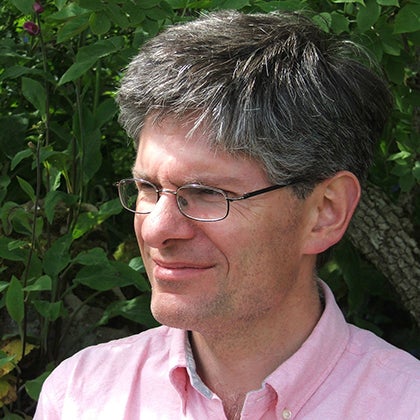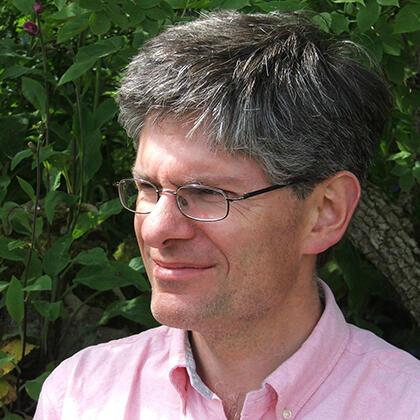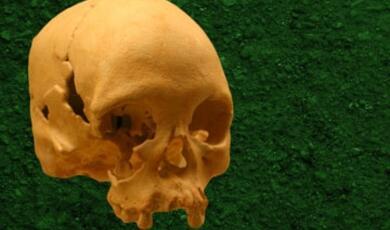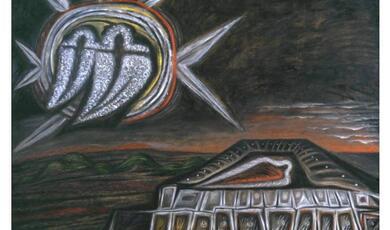Two Kingdoms in the Third Reich
Share
- Details
- Transcript
- Audio
- Downloads
- Extra Reading
Nazism was not a Christian movement in any meaningful sense but German Protestants of the 1920s and 1930s shared many Nazi assumptions and voted disproportionately for the Nazi party, partly in the hope that they might use it for their own ends. One result was the ‘German Christian’ movement, which tried to create a dejudaised Christianity which the Nazi state would accept with a place in the coming Aryan utopia. Many moderate, sensible Christians in Germany, even in the supposedly anti-Nazi 'Confessing Church', collaborated with the regime in other ways. This lecture will explore how so many Christians came to support Nazism, and how some managed to oppose it.
Download Transcript
9 March 2017
Two Kingdoms in the Third Reich
Professor Alec Ryrie
This is a series of lectures on ‘extreme Christianity’, and it does not get much more extreme than this. You are familiar with Godwin’s Law, also known as the reductio ad Hitlerum: the notion that every argument in the modern world eventually progresses to the point where someone invokes a Nazi comparison, and the whole thing then collapses. There is a reason for that. Thanks to the Nazis, since 1945 Western civilisation has had something which it had not had for at least two centuries before that: an all-but universally accepted reference point for evil. That is important for any attempt to understand our culture, but it is especially important from the point of view of the history of religion in the West. Because defining evil, the whole business of mapping out what morality is, is supposed to be the core business of any religious community. And in the case of Nazism, Europe’s main religious communities plainly failed to do this. The slow realisation of Nazism’s evil was an essentially secular event, and the fact that our public life is now organised around an essentially secular definition of evil seems to me to be a key fact in understanding the history of religion in modern times. Today I want to look at the sorry story of how German’s Christian communities responded to Nazism: a story of collaboration, enthusiastic enabling, and of strictly limited pushback.
Nazism itself was neither religious nor atheistic, in the normal senses of those words. Adolf Hitler never formally renounced his cradle Catholicism, but was vehemently anti-clerical and, by the end of his life, privately reviled Christianity as ‘a fairy story invented by the Jews’, a Jewish-Communist conspiracy against the German people. Yet he also dismissed atheism, the Communists’ creed, as subhuman, and mocked attempts by some Nazis to revive ancient Nordic paganisms. Since the Nazi party’s first formation in 1920, it had been formally committed to ‘positive Christianity’, but this slippery concept was defined largely by its opposition to ‘the Jewish-materialistic spirit’ and to individualism. Although Hitler thought Nazism should foster some ‘notion of divinity’, it found its spiritual meaning not in any god, but in the purity of the Aryan race, a purity whose highest expression was the Nazi state itself.[1]
During the eighteenth and nineteenth centuries, European and North American Jews slowly won legal rights and a measure of popular acceptance. However, anti-Judaism changed with the times, assuming two contradictory faces. For political conservatives, Jews became symbols of godless, socialist, commercial materialism. If you hankered for the old, simple, spiritually unified Germany – a naive and not quite innocent longing – the Jews might represent everything that stood in your way. In 1928 the leading Luther scholar Paul Althaus warned against a ‘disintegrated and demoralizing urban spirituality, whose representative now is primarily the Jewish race’.[2] By contrast, theologically liberal Christians found that new scholarship was letting them discard the old restraints on their anti-Jewish impulses. Almost-respectable historians began to suggest that ancient Galilee’s people had been mostly Gentile, and the supposed miracle of Jesus’ virgin birth was invented to conceal the fact he had been sired by a Roman soldier. Jesus’ parentage had once proved he was divine; now, even better, it proved he was a Gentile. Using the new categories which cutting-edge scientific racism was producing, he could even be optimistically classified as Aryan. Adolf von Harnack, the lion of German liberal theology, thought Christianity had moved so far beyond Judaism that the Old Testament might not belong in Christian Bibles at all. By the 1920s plenty of German Protestants felt it was merely tasteful to downplay the Old Testament, to cease giving children Old Testament names, and quietly to drop embarrassing Hebraisms such as ‘Hallelujah’ from modern church use.
So the Institute for the Study and Eradication of Jewish Influence in German Church Life, inaugurated in 1939 and better known simply as the Dejudaisation Institute, was not some ersatz Nazi project. It was launched in the Wartburg castle, where Martin Luther had translated the New Testament in 1521-2, a very deliberate attempt to claim the mantle of Germany’s most potent symbol of religious nationalism. Luther had been conscripted as a Nazi symbol since the beginning: in 1933 this poster declared that ‘Hitler’s struggle and Luther’s teaching are the best defence of the German people.’ His notorious pamphlet Of the Jews and their Lies was much reprinted by the Nazis. The Dejudaisation Institute’s director, the distinguished New Testament scholar Walter Grundmann, asserted in his inaugural lecture that the Institute’s work was nothing less than a second Reformation. Luther had thrown off the pope’s stranglehold on Christianity. Now, Grundmann declared, scholars had likewise revealed the ‘deformation of New Testament ideas into Old Testament preconceptions, so that now angry recognition of the Jewishness in the Old Testament and in parts of the New Testament has arisen’.[3] Christianity had to be purged of Jewishness. Any listener might logically conclude that it was therefore also time for Christendom to be purged of Jews.
Karl Barth, the Swiss Calvinist theologian who was the Nazis’ most formidable Christian theological opponent, wrote in 1939 that the two-kingdoms’ doctrine ‘lies like a cloud over the ecclesiastical thinking and action of more or less every course taken by the German Church’.[4] He had in mind a recent incident in which a pro-Nazi pressure group had challenged Germany’s Protestant ministers to take an oath to Hitler as Führer. Virtually all of them did so. Yes, the oath was terrifyingly plain, promising total submission with no heed to God, conscience or law. But Christian kings had demanded oaths from their subjects for centuries. When the nation’s rightful Führer asks this of his people now, how dare they refuse? Farcically, however, the regime refused to accept the oath. Martin Bormann, Hitler’s personal secretary and a consistent despiser of the churches, dismissed it as a purely voluntary and internal matter. Even when the state did not demand loyalty, Germany’s Protestants could not stop themselves from giving it.
Insofar as anyone avoided this trap, it was Dietrich Bonhoeffer, a young minister who was unusually quick to see Nazism for what it was. Yet in 1933 even Bonhoeffer accepted that there was a ‘Jewish question’ which the state needed to solve, and that it had considerable freedom to do so as it saw best. He initially found his way round the two-kingdoms principle by arguing that the secular state’s basic function was to preserve order, and that churches could therefore speak out when it failed to fulfill that function, by, for example, permitting lawless street violence. As he came to appreciate that street violence was the policy of the Nazi regime, Bonhoeffer avowed it was no longer a state at all, but a criminal conspiracy. It was an effective but rather a blunt solution. Bonhoeffer became an active plotter against the Nazi regime, and in April 1945 was hanged for it. In prison, he reflected on why so few Germans had been willing to defy ‘the radical evilness of evil’ that was Nazism. He blamed a fatal humility, which led to Germans being readier to trust their rulers’ decrees than their own instincts. It was virtuous in its way. But it meant that when the regime gave evil orders, Germans obeyed with ‘an irresponsible unscrupulousness’, scarcely bothering to consult their consciences. Yet when they considered defiance, those same consciences awoke into ‘an agonising scrupulosity which invariably frustrated action’.[5] Submission and obedience was always the path of least resistance.
The path was smoothed by less high-minded impulses. The regime terrorised the churches, not in most cases by direct attacks, but by ominous, implicit threats. In that first debate on anti-Semitic violence in April 1933, the president of the German Protestant Church’s executive committee admitted that he had not dared raise the matter with Hitler in person. It was already clear that this was not a regime which took kindly to opposition. Christians who were known to have reservations about it were regularly subject to frightening harassment. If Gestapo surveillance was not constant, it was assumed to be. There were periodic arrests, and if most victims were soon released, some were not. It was, Karl Barth wrote, a form of ‘death by strangulation’, slowly squeezing the spirit from churchmen until, after years of jumping at every shadow, they had little stamina for real defiance.[6]
But worse than theology and worse than fear, the church committee’s decision not to make an issue of anti-Semitism in April 1933 was hope. They had more exciting priorities. To worry about a few Jews, whose sufferings were probably exaggerated, was to miss the point: the Nazi seizure of power was a moment of national spiritual renewal. The epochal battle against Communist secularism had been won. Congregations were surging across the country, and the new government, unlike its secular predecessors, was committed to ‘positive Christianity’ and traditional Christian morality. When Paul Althaus, the Luther scholar who had earlier linked Jews to moral decay, exulted that ‘our Protestant churches have greeted the turning point of 1933 as a gift and miracle of God’, he was not referring to the Nazi seizure of power as such, but to a national awakening which stretched beyond mere politics.[7]
It was an opportunity that must not be squandered. ‘Use the hour!’ one church newsletter urged in mid-1933: ‘so that our church will once again be a people’s church and able to participate in the construction of our nation’.[8] The terms ‘people’ and ‘nation’ – Volk, in German - strongly implied that ‘non-Aryans’ were not welcome in this people’s church. But even if that seemed tasteless, carping over such details risked letting the moment slip through your fingers. If Nazism was a stepping-stone to a national Christian revival, then surely its uglier features would eventually fade away. In the meantime, the battle for the nation’s soul surely mattered more than a few Jews, whom a renewed Christian Germany would in any case rather do without?
For a short moment in the spring and summer of 1933, it looked as if the German Christians might end up controlling Germany’s Protestant churches as the party’s parachurch wing. Hitler appointed a hitherto obscure pastor from the movement, Ludwig Müller, as his special adviser on church affairs in April. He also pressed the Protestant church, then a loose national federation, to create a new, centralised structure led by a new Reich Bishop. The new constitution eventually adopted in June was rather less centralising than the regime had wished, and there was a deadlock over who this Reich Bishop might actually be. The regime resolved it by calling national church elections on less than a week’s notice. The German Christians, forewarned, presented slates of candidates everywhere, while the old establishment was left, dazed, on the starting-blocks. The day before the elections, Hitler made what would be his plainest ever intervention in church politics, in a radio broadcast praising the German Christians for their ‘solidarity with the national and cultural movement’. He urged Protestants to support them over ‘the unrealistic forces of religious ossification’.[9] German Christian candidates duly won two-thirds of the votes and took control of 24 of Germany’s 27 regional churches. The new Reich Bishop was none other than Hitler’s adviser Ludwig Müller. From then until 1945 – for there would be no more church elections – most of the formal structures of Germany’s established Protestant church would be firmly in German Christian hands.
That idea had theological consequences. If the nation was the fundamental unit of Christian life, then traditional Protestant preoccupations with individual salvation and eternal life were not only beside the point but tasteless. Who would want to share Heaven with non-Aryans? Or again, a truly German Christianity would have to be a Christianity for all true Germans. The German Christians arose in the Protestant church, but they wanted a single Reich church which would encompass Catholics too, even though neither the regime nor Germany’s Catholics were remotely interested in creating such an entity. More fundamentally, what of traditional Christian ethics? ‘We are not unacquainted with Christian love,’ the German Christians’ first manifesto reluctantly conceded in 1932, but they declared that the ‘living, active Christianity’ of the modern age had left behind such outmoded ethics as ‘mere pity’ and ‘charity’. True Christian love means protecting the nation ‘from the feckless and the inferior’. In 1939 Reich Bishop Müller was arguing that Christian love ‘hates everything soft and weak’, which has to be ‘cleared out of the way and destroyed’ for the people’s true life to flourish.[10]
This was not good news for Christians of Jewish descent, of whom there were some 50,000 in Germany. Some German Christians toyed with the idea that Aryan and Jewish Christians might coexist in separate churches. Others began to teach ever more plainly that mere baptism could not erase racial inferiority, refused to baptise would-be Jewish converts, and started to drive non-Aryan Christians from their churches. In December 1941, German Christian church leaders issued a declaration excluding all ‘racially Jewish Christians’ from their churches, on the grounds that the ‘racial essence’ of Jews cannot be changed by baptism.[11] By then, this was a symbolic statement. Germany’s remaining Jews were either in hiding or en route to the death camps.
And yet, the German Christians’ bid to become the Protestant wing of the Nazi party failed. Almost as soon as they had triumphed in the 1933 elections, the regime began to back away from them. Hitler’s deputy Rudolf Hess laid out a policy of strict religious neutrality, a policy which quickly vindicated itself. In November 1933, the leading German Christian Reinhold Krause told a huge rally at the Sports Palace in Berlin what a truly German Christianity meant. It meant ‘liberation from the Old Testament ... one of the most questionable books in the world’s history’. It meant ‘that the whole scape-goat and inferiority-type theology of the Rabbi Paul should be renounced’.[12] Tellingly, the 20,000-strong crowd cheered. Only when his words were widely reported did they become a scandal. Germany’s broad Christian centre was content to accept both Nazi rule and casual anti-Semitism, but this was another matter. Hundreds of German Christians resigned from the movement. One of these, in a vain attempt to protect his reputation, was Reich Bishop Müller: already a man plainly promoted above his competence, who only succeeded in undermining what authority he still had.
The party’s deliberate separation from any church factions after 1933 could not have been plainer. Members of the SS, the Nazis’ paramilitary wing, were barred from holding any church office. The German Christians were repeatedly warned and finally forced to stop using the swastika, although it still continued to be used in church decoration, and the Hitler Youth still kept a cross in their logo. In 1938, Hess explained that the party’s policy was to remain aloof from religious politics, so that the churches could quarrel themselves into oblivion and the people would ‘recognise that National Socialism is a God-ordained order and institution’.[13] When war came in 1939, the German Christians longed to provide military chaplains, to help the nation celebrate this great, uniting sacrament of blood. To their dismay, chaplains’ numbers and rights were systematically restricted. A so-called ‘Uriah law’ even had them deliberately sent to the front of combat. This was only a means of accelerating the view which Hitler had now privately reached, that ‘the best thing is to let Christianity die a natural death’. For the time being, he would not support any open attack. ‘The ideal solution would be to leave the religions to devour themselves, without persecutions.’ But in another mood, he would add: ‘If I ever have the slightest suspicion that they are getting dangerous, I will shoot the lot of them.’[14] In the Third Reich, the only privilege for which even the most abjectly loyal church could ultimately hope was a quiet death.
Still the German Christians tried, vainly, to demonstrate the compatibility of their beliefs with Nazism. The clergy’s 1938 oath of loyalty to Hitler, which the regime refused to recognise, was a German Christian project. In 1939 the German Christian leaderships of eleven regional churches produced a declaration describing Christianity as ‘the irreconcilable religious opposite of Judaism’. Still the regime would not bite. During the war, some German Christian churches took to declaring themselves ‘officially anti-Jewish’. In 1944 one German Christian publication even looked forward to a post-war world ‘completely purged of Judaism’, an unusually direct reference to the Final Solution.[15] But no matter how much hatred they had to offer, the Nazi regime was not interested.
In fact, nothing could demonstrate its futility better than these books. Dejudaised Christianity turned out to be pretty thin gruel. Nearly half of the hymnbook consisted of secular German lyrics. The rest had been purged of anything reflective or penitential, and indeed almost of any reference to Christian doctrine. Militaristic triumphalism and domestic sentimentality were all that was left. The Volkstestament was more complex, for its editors had not been able to eliminate Judaism entirely. Although Jesus’ racial identity is not stated, he still teaches in the Jewish temple, and even, daringly, quotes a Jewish psalm. Nor could St Paul’s Jewishness be avoided: this was why some German Christians had wanted to drop him altogether. A few even argued that the very idea of Scripture was a Jewish perversion. ‘Whereas the Jews were the first to write out their faith, Jesus never did so.’[16] It is often said that you can twist the Bible to mean anything. But the efforts of the Dejudaisation Institute prove that, even if you abandon almost all of it, there are still meanings which it will simply refuse to bear.
The regime still had no wish to sponsor this almost content-free faith. In 1941 Walter Grundmann, the Institute’s director, was bluntly told by an official in the Propaganda Ministry that ‘there is no interest in synthesizing Christian teachings with National Socialism, nor proving that a reshaped Christianity is not fundamentally Jewish’.[17] It is almost pitiable. Emptying Christianity of all its substance did not, he discovered, make anyone want the husk. But it will not do to feel too sorry for Grundmann. His Institute, while it lasted, seems to have been a thoroughly agreeable place to work. Most of its alumni managed to shake off any unpleasant associations after the war and to go on to very successful academic careers. Grundmann himself, after a cursory show of repentance, became both the rector of a prestigious seminary in East Germany and an active informer for the East German secret police.
So far this has been a pretty bitter story. You will be thinking, was there not another side to it? Was there not some resistance, some courage? And yes, there was. Up to a point. Some in Germany’s Protestant church were queasy about the new regime from the beginning. When the church elections were called in June 1933, the German Christians did not quite sweep the board: a fledgling movement calling itself ‘Gospel and Church’, arguing for strict independence for the church, managed to win control of three of Germany’s 27 regional Protestant churches, when the rest fell to the German Christians. Those three,[18] soon known as the ‘intact churches’, as against the ‘destroyed churches’ in the rest of Germany – gave non-Nazi Christianity an institutional foothold. As worries about the German Christians’ overreach spread through the churches in late 1933 and early 1934, those three regional churches and concerned ministers and people across Germany formed themselves into a formal entity called the Confessing Church. Over a third of Germany’s 18,000 Protestant ministers affiliated to it, and although that number did fall away somewhat, it remained higher than the number who were avowed German Christians. Nothing else quite like this happened under Nazi rule – the formation of a genuinely independent nationwide organisation defined by its rejection of a quasi-Nazi ideology. Its formation and its survival throughout the Nazi Reich is a double demonstration of weakness. It shows the weakness of the Nazi regime, which for all its pretensions to totalitarianism could not in fact police hundreds of thousands of believers. It dared not risk puncturing the illusion of one people united behind one Führer by openly attacking a mass movement, not when it was still trying to pass off its own ideology as ‘positive Christianity’. But it also shows the weakness of the Confessing Church itself, which never truly stood against the Nazi regime. Its achievement was to defend its own independence. The price was to let the regime have its own way on almost, but not quite, everything else.
The Confessing Church was defined not by politics but by theology. It was the Church of old-fashioned Protestant orthodoxy: Scripture, the historic confessions, justification by faith alone. The chief accusation it levelled at the German Christians was heresy. For many Confessors, the German Christians’ worst offence was not the Aryan paragraph, but their doomed attempt to reach out to Catholicism. Plenty of Protestants still remembered that the Pope was Antichrist, and their most heartfelt objection to the German Christians was their intolerable tolerance. They rejected state control on similar grounds. An early Confession Church synod rejected the application of the ‘Führer principle’ to church life, on the grounds that it was ‘a Papal hegemony unthinkable within the evangelical church’.[19]
This is not a story entirely without heroes. A handful of Germany’s Christians did try to act. The best known is Dietrich Bonhoeffer, who as late as 1942 had a hand in a complex, risky plot which successfully smuggled 14 Jews to Switzerland, and who was hanged in April 1945 for his peripheral involvement in the previous year’s failed plot to assassinate Hitler. There were others: in the late 1930s the Berlin pastor Heinrich Grüber organised a scheme which arranged safe passage abroad for over 1,700 Jews. But the only Christian group to defy Nazism en masse were the Jehovah’s Witnesses, who in 1937 managed to distribute in one day 300,000 copies of a secretly printed leaflet condemning Hitler as the apocalyptic Beast. The Confessing Church’s greatest theological leader, Karl Barth, who was also one of its most anomalous figures, was merciless towards his colleagues. He described most Christians in Germany as an army of neutrals ... whose symbol consists of two thick blinkers and whose ecclesiastical desire is to be dangerous to no-one, thus letting themselves be in no danger.[20]
Bold words, and Barth did not want for courage. But relatively easy for him to say. Barth was a Swiss citizen, and once his opposition to Hitler had cost him his job at a German university and seen him deported in 1935, there was little more the Nazis could do to him. He had not endured the 1914-18 war, nor had he been weaned on myths of German national greatness and humiliation. But if he was immune to Nazi cant, he was susceptible to his own national myths. Although he argued in 1938-9 that other countries had a duty to fight the Nazis, he backed Swiss neutrality, claiming awkwardly that Switzerland’s peculiar calling among the nations was to be a place of tranquillity amid the storm. It is not to question his sincerity to point out that these were safe and easy sentiments to express. And even then, his critique of Nazism was fundamentally a theological one. On a visit to Britain in 1938, he was asked why the Confessing Church had said so little against the concentration camps. Other than begging the audience’s understanding of the Confessors’ precarious situation, he had no answer. Even for Barth, the priority was to keep the Church pure and undefiled, not to stand against the greatest crimes of the age.[21]
The extent of those crimes was still largely hidden, especially for those who preferred to avert their eyes, as most people do when faced with horrors. The Confessing Church remained silent about the Nazi state’s atrocities until very late in the day. In January 1943 Theophil Wurm, bishop of the ‘intact’ church of Württemberg, wrote to the Interior Ministry protesting at ‘the manner in which the war is being conducted against other races and peoples’, and in particular ‘the systematic murder of Jews and Poles’. This is not only a gross violation of God’s law, but, he added shrewdly, unbecoming of a cultured people. He put it in the context of Germany’s recent, unexpected military reversals: perhaps the nation had forfeited God’s favour?[22] It is telling, however, that he preferred discreet lobbying to any kind of public protest. It was later the same year that a Confessing Church synod at Breslau offered something unique in Nazi Germany: a public condemnation of genocide. Insisting that all human life, ‘including the life of the people of Israel’, is sacred, it warned, ‘Woe unto us and our nation ... when the killing of men is justified on the grounds that they are unfit to live or that they belong to another race.’[23]
Meanwhile the crematoria kept busy. By the summer of 1941 some 70,000 patients had been killed. What tipped the balance was a public intervention, not by a Protestant bishop, but a Catholic one. On 3 August 1941, Clemens Graf van Galen, the bishop of Münster, preached a devastating sermon against Action T4. With forensic care, he laid out both the horror of what was happening and its moral implications. He also took steps to ensure that this remarkable intervention reached beyond his audience in the St Lambert Church that day. The sermon was printed in secret and circulated widely. British bombers dropped copies. A Confessing Church synod claimed that the sermon was ‘whispered from mouth to mouth throughout Germany’.[24]
‘I am quite sure,’ Hitler fumed, ‘that a man like the Bishop van Galen knows full well that after the war I shall exact retribution to the last farthing.’[25] But he also backed down. The disquiet which van Galen had brought to simmering point was more trouble than it was worth. On 24 August, Hitler signed an order ending Action T4. The murders did not actually end, and deliberate neglect and medical experiments also continued to claim patients’ lives. But the rate of killing slowed dramatically.
[7] Ericksen, ‘Assessing the Heritage’, 23-5.
[9] Matheson, Third Reich, 28.
[11] Bergen, Twisted Cross 24, 26.
[12] Matheson, Third Reich, 39.
[13] Matheson, Third Reich, 75.
[14] Hitler’s Table Talk, 6, 59, 625.
[15] Bergen, Twisted Cross, 24, 26.
[16] Bergen, Twisted Cross, 47.
[17] Heschel, Aryan Jesus, 150.
[18] Bavaria, Hanover and Württemberg
[19] Matheson, Third Reich, 50.
[20] Barth, German Church Conflict, 75.
[21] John Bowden, Karl Barth (London: SCM Press, 1971), 74.
[22] Matheson, Third Reich, 97-8.
[23] Matheson, Third Reich, 99.
Part of:
This event was on Thu, 09 Mar 2017
Support Gresham
Gresham College has offered an outstanding education to the public free of charge for over 400 years. Today, Gresham plays an important role in fostering a love of learning and a greater understanding of ourselves and the world around us. Your donation will help to widen our reach and to broaden our audience, allowing more people to benefit from a high-quality education from some of the brightest minds.


 Login
Login







